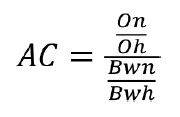Introduction
Accelerated demographic growth generates increasing consumption of animal protein, enhancing poultry farming development over the last years, from agricultural systems where chickens were fed seeds and natural food products like worms or earthworms; to technified farming systems (16). In the present decade, poultry meat production leads meat production growth by 50% and is projected to occupy first place worldwide in 2030 (15).
In Ecuador, poultry production registers 1819 poultry farms generating 32000 job positions, 220000 indirect sources and around 2000 million dollars a year, that is, 16% of the agricultural GDP and 2% of the total GDP. The country’s chicken meat production is mainly distributed among the provinces of Guayas with 22%, Pichincha with 16% and Santo Domingo de los Tsáchilas with 14%. Performing an economic analysis between 2018 and 2019, Ecuadorian poultry has gradually grown 27% (5).
Besides being a low-fat and low-calorie meat, chicken meat contributes a high biological value protein, essential and non-essential amino acids for human nutrition, B-complex vitamins and minerals such as iron, selenium, and copper (22). However, the choice for more productive animals and the increasing use of antibiotics favour stress conditions, increasing deficiencies in intestinal microbiota and producing a consequent lower natural resistance to pathogenic microorganisms (8).
The current excessive expenditure for feed in poultry diets has negatively affected productivity (22). However, new organic sources of minerals such as zinc, together with the addition of lactic acid bacteria such as L. bulgaricus, have been safely used in the feeding of other animal species, with several benefits. Therefore, the main objective of this research was to evaluate the effect of zinc lactate and Lactobacillus bulgaricus supplementation on broilers gastrointestinal microbiota (13).
Materials and methods
The study was conducted on the property of Mr Cusme Manzaba, located in the Camareta site of the Santa Rita parish of the Chone canton in the province of Manabi. The area is located 45 m.a.s.l., with an average temperature of 28°C, annual rainfall of 1025 mm and relative humidity of 83%.
A total of 300 healthy one-day-old broilers, with an average initial weight of 47 g were arranged in a completely randomized design with four treatments, five replicates and fifteen broilers per experimental unit. Three levels of zinc lactate plus the probiotic (w/w ratio) were evaluated weekly in a proportional manner (Table 1), according to Shah et al. (2018) defining zootechnical, productive and sensory behaviour of broilers.
Table 1 Experimental design. Tabla 1. Descripción del diseño experimental usado en la investigación.

The chickens’ diet (Table 2) was corn-based, and following the guidelines of the National Research Council (1994), the basal diet adopted three phases of feeding, initial (1-14 days), growth (15-28 days) and final (29-42 days). Food and water were provided ad libitum. Crude protein (Nx6.25), dry matter, fat and crude fibre were determined using the standard methods described in the AOAC (1).
Table 2 Proximal chemical analysis and Apparent Metabolizable Energy calculation of starter, grower and finisher diets for broilers. Tabla 2. Análisis químico proximal y cálculo de energía metabolizable aparente de dietas de iniciación, crecimiento y finalización para pollos de engorde.
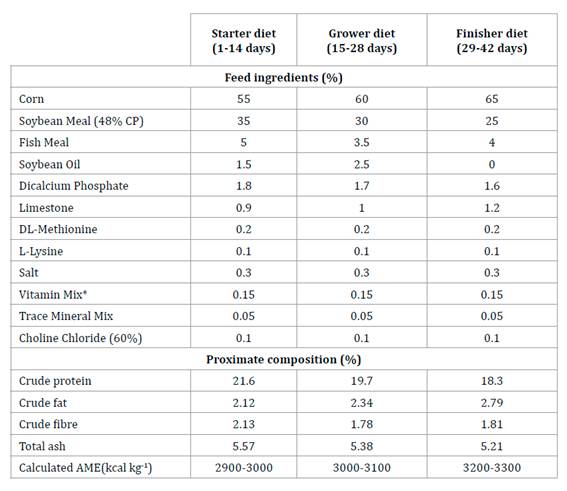
*Vitamin mineral mix (each kg contained): Ca: 195g; K: 70g; Na: 18g; Mg: 6g; Zn:29mg; Fe: 2000mg; Cu: 400mg; Mn: 1200mg; Se: 8mg; Co: 20mg; I: 40mg; vitamim A: 200000IU; vitamin D3: 80000IU; vitamin E: 1072IU; vitamin K3: 34mg; ascorbic acid: 1300mg; thiamine: 35mg; riboflavin: 135mg; niacin:1340mg; vitamin B6: 100mg; folic acid: 34mg; vitamin B12: 670ug and biotin: 3350ug. AME: Apparent Metabolizable Energy.
*Mezcla de vitaminas y minerales (cada kg contenía): Ca: 195g; K: 70g; Na: 18g; Mg: 6g; Zn: 29mg; Fe: 2000mg; Cu: 400mg; Mn: 1200mg; Se: 8mg; Co: 20mg; I: 40mg; vitamina A: 200000UI; vitamina D3: 80000UI; vitamina E: 1072UI; vitamina K3: 34mg; ácido ascórbico: 1300mg; tiamina: 35mg; riboflavina: 135mg; niacina:1340mg; vitamina B6: 100mg; ácido fólico: 34mg; vitamina B12: 670ug y biotina: 3350ug. AME: Energía Metabolizable Aparente.
Zootechnical parameters
The following productivity parameters were evaluated on days 7, 14, 21, 28, 35 and 42. Weekly weight gain Live weight of the chickens was weekly assessed and weight gain calculated according to Madrid Garcés et al. (2022).
Feed conversion ratio
This parameter determines consumed feed weight over animal weight gain. The lower the feed conversion ratio, the more efficient animal raising (7).
European Efficiency Index (EEI)
This index compares different flocks within an integration. The minimum value expected is 200. Any result below 200 defines low performance (6).
Allometric parameters
During the staggered euthanasia (according to Comité de Bioética de la Universidad Técnica de Manabí), 40 birds were sacrificed as follows: on days 21 and 42, one chicken was sacrificed for each replicate. Animals were stunned by applying a carbon dioxide atmosphere for 3 minutes. All birds were sacrificed 3 hours after the last meal.
Allometric growth
To determine organ ontogenesis and its relationship with body weight, the allometric growth constant (AC), proposed by Campos et al. (2022) was used.
where:
O = organ weight
n = days after birth
h = birth weight
BW = body weight
When the organ grows in the same proportion to body weight, CA equals 1. If organ growth is below body weight, CA is smaller than 1. For CA over 1, relative growth to total body weight gain is accelerated (11).
Small intestine morphometry
After 48 hours of collection, samples from different sections of the intestine were preserved in 10% formalin, then embedded in kerosene, cut at 4μm thickness and stained with hematoxylin-eosin to be washed and stored in ethanol:water (75:25, v:v) according to Chávez et al. (2016).
Intestinal villi
Height: once villus base was established, a line from midpoint to apex defined height. Width: distance between apical edges of epithelial cells from opposite sides, located approximately in the middle of the villus.
Crypts of Lieberkühn
According to Quevedo et al. (2020), depth and width of Lieberkühn crypts (mm) were determined using an optical microscope with a micrometre eyepiece.
Microbiological parameters
For the microbiological analysis of mesophilic aerobes, enterobacteria and lactobacillus, samples of the small intestine and muscle were taken from 3 chickens per treatment (one per replicate) and taken to perform microbial culture (2).
Results and discussion
Analysis of zootechnical and productive parameters
All chickens considered in the 3 treatments with zinc lactate and L. bulgaricus in the basal diet presented optimal state of health, during the study phase. No statistical interactions were found between the treatments for any of the variables considered. Independent effects were analyzed.
Regarding feed consumption (Kg animal-1), significant differences between treatments were observed, where the chicks in T1 had the lowest feed consumption compared to the other treatments (p<0.05; Table 3). It is worth mentioning that the chickens subjected to T0 presented higher feed consumption, while the rest of the chickens subjected to T2 and T3 had moderate feed consumption. Regarding weight (Kg animal-1), significant differences were also found.
Table 3 Zootechnical and productive analysis of broilers subjected to zinc lactate and L. bulgaricus supplementation in the basal diet for 42 days. Tabla 3. Análisis productivo y zootécnico de pollos de engorde sujetos a suplementación de lactato de zinc y L. bulgaricus en la dieta basal por 42 días.
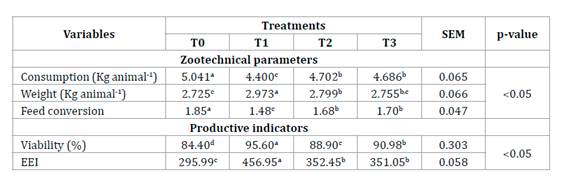
EEI = European Efficiency Index. SEM = Standard Error of the Mean. Groups according to p-value 0.05. Different letters show significant differences among means.
EEI = European. Efficiency Index. SEM = Error Estándar de la Media. Los grupos se clasifican según la probabilidad de que exista una diferencia significativa entre sus medias, tomando en cuenta un nivel alfa de 0,05.
The best broiler feed conversion was achieved with T1 (1.48). Percentage of viability and the European Efficiency Index were also achieved in T1, values closely related to those obtained by Shah et al. (2018) when determining the effect of zinc and probiotics on the performance and morphology of immune organs in heat-stressed broilers. The authors stated that zinc and probiotics vary in effectiveness according to intestinal absorption degrees and subsequent blood bioavailability. On the other hand, according to González-Vásquez et al. (2020), the concentration of zinc lactate recommended for poultry diets should be approximately 40mg Kg-1 and 75mg Kg-1 of feed. In the present study, we obtained better benefits with 40 mg of zinc lactate and 15 mg of probiotic per Kg of feed.
Significant differences (p<0.05) were evidenced for organ weight (%PV) during this research, where the gizzard reached average weight (2.269%), liver (2.928%) and small intestine (6.312%). It should be noted that both the liver and small intestine obtained the highest weights at T1, while the gizzar reached the highest weight at T3 (2.443%).
Organ allometric analysis showed statistically significant differences (p<0.05). Chicken gizzard presented an average growth (CA=0.49), liver (CA=0.62) and small intestine (CA=0.47), all “slow growth values” (CA<1) in relation to body weight (Table 4).
Table 4 Organ weight (%OW) and allometric analysis of broilers under supplementation with zinc lactate and probiotic (L. bulgaricus) for 42 days. Tabla 4. Peso del órgano (%PO) y análisis alométrico de pollos de engorde que se sometieron a suplementación de la dieta basal con lactato de zinc y probióticos (L. bulgaricus) durante 42 días.
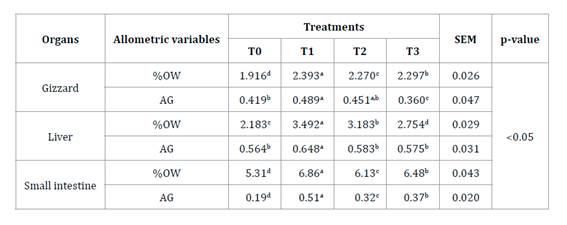
%OW = organ weight. AG = allometric growth. SEM = Standard Error of the Mean. Groups according to p-value 0.05. Means with the same letter are not significantly different.
%PO = peso del órgano. CA = crecimiento alométrico. EEM = Error estándar de la media. Los grupos se clasifican según la probabilidad de que exista una diferencia significativa entre sus medias, tomando en cuenta un nivel alfa de 0,05.
Consumption of zinc lactate and probiotics enhances productive parameters and influences weight and organ development, particularly intestine (23).
Higher organ weights were found in chickens subjected to T1 (basal diet plus 30 mg of zinc lactate and 10 mg of probiotic Kg-1). the amount of zinc lactate and probiotics to be added, should not surpass the indicated amounts since they can cause an opposite effect such as poor nutrient retention, low weight gain and low organ development (2).
Providing broilers with diets including zinc lactate and probiotics, improve digestive performance. This research verified the positive effect of adding zinc lactate and probiotics to conventional feed. In accordance with previous studies (18,21), animal metabolic processes as well as nutrient absorption were more efficient.
Morphometry of the small intestine
Table 5 (page 126), presents histomorphological variables corresponding to significant interactions between Zn and probiotic mixture.
Table 5 Effect of dietary zinc lactate and L. bulgaricus on histomorphology parameters of the small intestine of broiler chickens at 42 days of age. Tabla 5. Efecto de la inclusión de lactato de zinc y L. bulgaricus en la dieta sobre parámetros histomorfológicos del intestino delgado de pollos de engorde a los 42 días de edad.

H-iv = height of intestinal villi. W-iv = width of intestinal villi. CD = crypt depth. SEM = Standard Error of the Mean. Groups according to p-value 0.05.
H-iv = Altura de las vellosidades intestinales. W-iv = Ancho de las vellosidades intestinales. CD = Profundidad de la cripta. SEM = Error estándar de la media. Los grupos se clasifican según la probabilidad de que exista una diferencia significativa entre sus medias, tomando en cuenta un nivel alfa de 0,05.
According to Iñiguez Heredia et al. (2021) probiotics and organic acids are important fattening stimulants. These authors state that Lieberkühn crypts in intestines have a key role in determining enzymatic effects. In this context, we observed variations, however non-significant, in height and width of intestinal villi between T1 and T0, T2, T3. Crypts resulted deeper in T1, than in T0, T2 and T3.
Microbiological analysis
Table 6 shows statistical differences between treatments for populations of enterobacteria, mesophiles and lactobacillus. Mesophilic bacteria showed 8.2 log CFU g-1 for T0 and 8.9 log CFU g-1 for T3, respectively, remaining stable between all treatments, in accordance with González-Vásquez et al. (2020), who found no statistical differences in the population of mesophilic aerobes in chicken ileum.
Table 6 Counting of bacterial populations in chicken small intestine. Tabla 6. Conteo de poblaciones bacterianas en el intestino delgado del pollo.
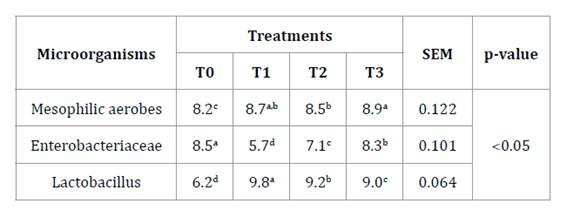
Groups by probability of mean difference and alpha level (0.05) SEM = Standard Error of the Mean Groups according to p-value 0.05.
Los grupos se clasifican según la probabilidad de que exista una diferencia significativa entre sus medias, tomando en cuenta un nivel alfa de 0,05. SEM = Error Estándar de la Media.
Enterobacteria yielded significant differences in all treatments. The presence of enterobacteria (gram-negative bacteria) was lower for T1, as stated by Rebollada-Merino et al. (2020) when adding antibiotics and prebiotics to chicken basal diet.
Regarding lactic acid bacteria, T1 presented the highest count. Lactobacillus bacteria had the lowest presence for treatment T0, (6.3 log CFU g-1) and the highest presence in T1 with 9.9 log CFU g-1 This, according to Blajman et al. (2015), helps improve gastrointestinal flora, inhibiting pathogenic microorganisms and enhancing immunology, thus improving general growth.
Conclusion
Zinc lactate and L. bulgaricus in the basal diet of broilers allowed obtaining better sanitary conditions in organic production since performance of broiler management is evaluated in terms of zootechnical, allometric, histomorphology and microbiological parameters of small intestine resulting in greater villi growth and decreased enterobacteria and mesophilic aerobes populations.


















